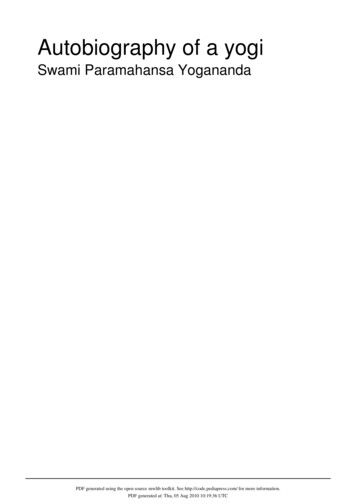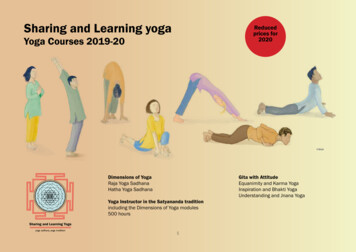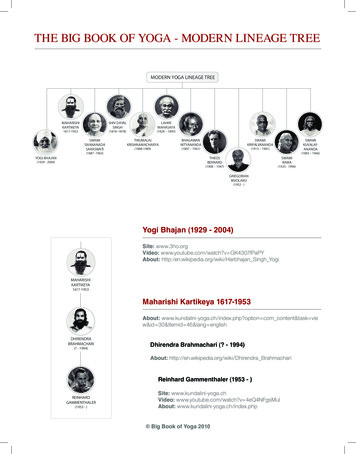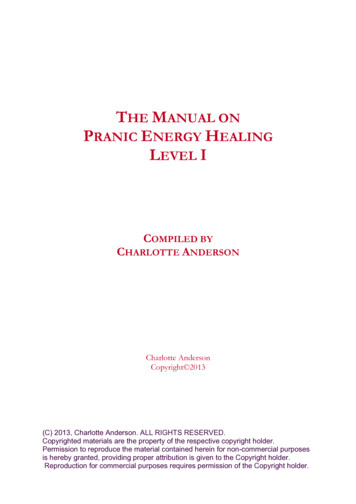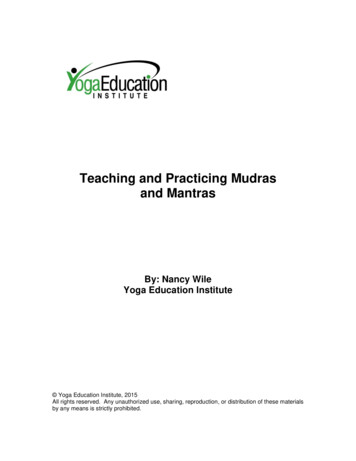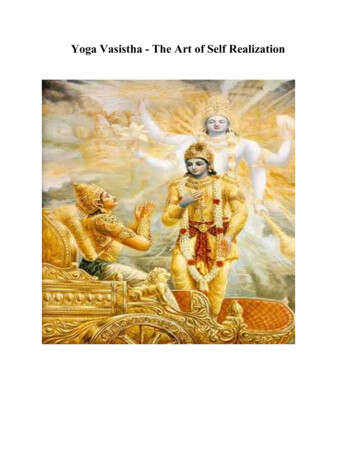
Transcription
Hatha Yogai
Hatha YogaWritingsThe Hindu‑Yogi Science of BreathHatha Yoga or The Yogi Philosophy of Physical Well‑BeingFourteen Lessons in Yogi Philosophy and Oriental OccultismAdvanced Course in Yogi Philosophy and Oriental OccultismThe Science of Psychic HealingA Series of Lessons in Raja YogaThe Bhagavad Gita or The Message of the MasterThe Spirit of the UpanishadsA Series of Lessons in Gnani YogaA Series of Lessons in Mystic Christianity or The Inner Teachings of the MasterThe Hindu‑Yogi System of Practical Water CureLife Beyond DeathA Series of Lessons on The Inner Teachings of The Philosophies and Religions of Indiaii
Hatha YogaorThe Yogi Philosophy of PhysicalWell‑Being1904Yogi Ramacharaka1862–1932信YOGeBooks: Hollister, MO2014:08:05:15:22:24iii
Hatha YogaCopyrightYOGeBooks by Roger L. Cole, Hollister, MO 65672 2010 YOGeBooks by Roger L. ColeAll rights reserved. Electronic edition published 2010isbn: 978‑1‑61183‑002‑6 (pdf)isbn: 978‑1‑61183‑003‑3 (epub)www.yogebooks.comiv
DedicationTo the healthy man and woman this book is respectfullydedicated.They have done certain things (consciously or subconsciously)in order to bring themselves from infancy to healthy, normalmaturity. And if you (who may not be so healthy and normal)will do just these same things, there is no reason why you, too,should not be just as are they. And this little book is our attemptto tell you just what this healthy man and woman did in orderto be just what they are.Read it, and then go and do likewise, so far as you are able.If you doubt the truth of our statements, find some healthyman or woman, and watch him, or her, closely, and see whetherhe, or she, does not do the things we have pointed out to youto do in this book—and whether he, or she, does not leaveundone the things we have asked you to avoid. We are willingto submit our teachings to this severe test—apply it.v
Hatha Yogavi
ContentsChapter I. What is “Hatha Yoga.”Chapter II. The Yogis’ Regard for the Physical Body.Chapter III. The Work of the Divine Architect.Chapter IV. Our Friend, the Vital Force.Chapter V. The Laboratory of the Body.Chapter VI. The Life Fluid.Chapter VII. The Crematory of the System.Chapter VIII. Nourishment.Chapter IX. Hunger vs. Appetite.Chapter X. The Yogi Theory and Practice of Prana Absorption from Food.Chapter XI. About Food.Chapter XII. The Irrigation of the Body.Chapter XIII. The Ashes of the System.Chapter XIV. Yogi Breathing.Chapter XV. Effect of Correct Breathing.Chapter XVI. Breathing Exercises.Chapter XVII. Nostril‑Breathing vs. Mouth‑Breathing.Chapter XVIII. The Little Lives of the Body.Chapter XIX. The Control of the Involuntary System.Chapter XX. Pranic Energy.Chapter XXI. Pranic Exercises.Chapter XXII. The Science of Relaxation.vii
Hatha YogaChapter XXIII. Rules for Relaxation.Chapter XXIV. The Use of Physical Exercise.Chapter XXV. Some Yogi Physical Exercises.Chapter XXVI. The Yogi Bath.Chapter XXVII. The Solar Energy.Chapter XXVIII. Fresh Air.Chapter XXIX. Nature’s Sweet Restorer—Sleep.Chapter XXX. Regeneration.Chapter XXXI. The Mental Attitude.Chapter XXXII. Lead by the Spirit.viii
Publisher’s NoticeOur original intention, when we arranged for thepublication of this book, and, in fact almost up untilit went to press, was that it should be, in a measure,supplementary to our little book, “Science of Breath,” by thesame author—that is to say, it should take up the subject of“Hatha Yoga” with the exception of that phase of the subject(breathing, etc.) which has been covered in that book. But atthe last moment we decided that it would be a mistake topublish a book on “Hatha Yoga” with such an important part ofthe subject as Yogi Breathing omitted, even though that subjecthad been covered in another book. To omit that importantphase of the subject would be working an injustice to thosewho purchased the new book, as many of such purchaserswould never have read the first book, and would be justified inexpecting that the present book would treat of all phases of thegeneral subject. So, we decided to incorporate in the presentvolume those parts of “Science of Breath” which belongedstrictly to the subject of “Hatha Yoga,” omitting such portionsas belonged rather to the other branch of the Yogi Philosophy,i. e., Raja Yoga. We mention these facts that the purchasersof this book, who have also read our former book, might notaccuse us of filling a new book with parts of an old one. Weix
Hatha Yogaadvertised this book, intending to give only the supplementalparts, as above stated, and the portions of “Science of Breath,”which have been added thereto, have been inserted at our ownexpense, and in the nature of “good measure,” or the “baker’sdozen.”It is probable that, at some future time, we will makearrangements with the same author to take up the “Raja Yoga”portions of “Science of Breath,” and to amplify and enlarge uponsame, adding to the foundation already built, just as he hasdone in the present book upon the “Hatha Yoga” foundationcontained in the little book first published by us. If this courseis followed, the present book, “Hatha Yoga,” will be the first ofa series of “Yogi Books,” taking up, in succession, the differentphases of the great Yogi Philosophy, the little book “Science ofBreath” serving as an introduction to the series, and as a handylittle book for beginners, or those just becoming interested inthe subject.“Hatha Yoga,” the present book, deals altogether with thephysical. The psychical, mental and spiritual phases of thesubject belong to the other branches of the work. “Hatha Yoga,”however, will be a splendid foundation upon which the studentmay build, as a sound, strong, healthy body is necessary for oneto do his best work and study, as the author of this book has sowell explained in the text.We have asked the author to write a preface to this book, butthis he declines to do, as he feels that the book should speakfor itself, and he does not like the idea of (as he expresses it)“intruding his personality” upon his readers, holding that truthshould be self‑evident and needing no personal touch to makeit truth. This notice, therefore, will take the place of a prefacein this case.Yogi Publication Society.Chicago, Ill., August, 1904.x
Hatha Yoga1
Hatha Yoga2
Chapter I.TWhat is “Hatha Yoga.”he science of Yoga is divided into several branches. Amongthe best known and leading divisions are (1) Hatha Yoga;(2) Raja Yoga; (3) Karma Yoga; (4) Gnani Yoga. This bookis devoted only to the first named, and we will not attemptto describe the others at this time, although we will havesomething to say upon all of these great branches of Yoga, infuture writings.Hatha Yoga is that branch of the Yoga Philosophy whichdeals with the physical body—its care—its well‑being—itshealth—its strength—and all that tends to keep it in its naturaland normal state of health. It teaches a natural mode of livingand voices the cry which has been taken up by many of theWestern world: “Let us get back to Nature,” excepting that theYogi does not have to get back for he is already there, for he hasalways clung close to nature and her ways, and has not beendazzled and befooled by the mad rush toward externals whichhas caused the modern civilized races to forget that such athing as nature existed. Fashions and social ambitions have notreached the Yogi’s consciousness—he smiles at these things,and regards them as he does the pretenses of childish games—he has not been lured from nature’s arms, but continues to3
Hatha Yogacuddle close up to the bosom of his good mother who hasalways given him nourishment, warmth and protection. HathaYoga is first, nature; second, nature, and last, nature. Whenconfronted with a choice of methods, plans, theories, etc., applyto them the touchstone: “Which is the natural way,” and alwayschoose that which seems to conform the nearest to nature. Thisplan will be a good one for our students to follow when theirattention is directed to the many theories; “fads”; methods;plans and ideas, along health lines, with which the Westernworld is being flooded. For instance if they are asked to believethat they are in danger of losing their “magnetism”, by comingin contact with the earth, and are advised to wear rubber solesand heels upon their shoes, and to sleep in beds “insulated”with glass feet, to prevent nature (mother Earth) from suckingand drawing out of them the magnetism which she has justgiven them, let the students ask themselves “What does Naturesay about this?” Then, in order to find out what nature says, letthem see whether nature’s plans could have contemplated themanufacture and wearing of rubber soles, and glass feet for beds.Let them see whether the strong magnetic men, full of vitality,do these things—let them see whether the most vigorous racesin the world have done these things—let them see whetherthey feel debilitated from lying down on the grassy sward, orwhether the natural impulse of man is not to fling recliningon the bosom of their good mother earth, and whether thenatural, impulse of man is not to fling himself upon the grassybank—let them see whether the natural impulse of childhoodis not to run barefoot; whether it does not refresh the feetto take off the shoes (rubber soles and all) and walk aroundbarefooted; whether rubber boots are particularly conduciveto “magnetism” and vitality, and so on. We give this merely asan illustration, not that we wish to waste time in discussingthe merits or demerits of rubber soles, and glass bed feet as apreservative of magnetism. A little observation will teach theman that all of nature’s answers show him that he gets much of4
What is “Hatha Yoga.”his magnetism from the earth, and that the earth is a batterycharged with it, and is always willing and anxious to give forthits strength to man, instead of being devoid of it and to bedreaded as being anxious and likely to “draw” the magnetismfrom man, its child. Some of these latter day prophets will nextbe teaching that the air draws Prana from people, instead ofgiving it to them.So, by all means, apply the nature test to all theories of thiskind—our own included—and if they do not square withnature, discard them—the rule is a safe one. Nature knowswhat it is about—she is your friend and not your enemy.There have been many and most valuable works written onthe other branches of the Yogi Philosophy, but the subject ofHatha Yoga has been dismissed with a brief reference by most ofthe writers upon Yoga. This is largely due to the fact that in Indiathere exists a horde of ignorant mendicants of the lower fakirclass, who pose as Hatha Yogis, but who have not the slightestconception of the underlying principles of that branch of Yoga.These people content themselves with obtaining control oversome of the involuntary muscles of the body (a thing possibleto anyone who will devote to it the time and trouble necessaryfor its accomplishment), thereby acquiring the ability toperform certain abnormal “tricks” which they exhibit to amuseand entertain (or disgust) Western travelers. Some of their featsare quite wonderful, when regarded from the standpoint ofcuriosity, and the performers would be worthy applicants forpaying positions in the “dime museums” of America, indeedtheir feats being very similar to some performed by some ofthe Western “freaks.” We hear of these people exhibiting withpride such tricks and acquired habits as, for instance the abilityto reverse the peristaltic action of the bowels and intestines,and the swallowing movements of the gullet, so as to give adisgusting exhibition of a complete reversal of the normalprocesses of those parts of the body, so that articles introducedinto the colon may be carried upward and ejected from the5
Hatha Yogagullet, by this reversed movement of the involuntary muscles,etc. This, from a physician’s point of view, is most interesting,but to the layman is a most disgusting thing, and one utterlyunworthy of a man. Other feats of these so‑called Hatha Yogisare about on a par with the instance which we have reluctantlygiven, and we know of nothing that they perform which is ofthe slightest interest or benefit to the man or woman seekingto maintain a healthy, normal, natural body. These mendicantsare akin to the class of fanatics in India who assume the title“Yogi”, and who refuse to wash the body, for religious reasons; orwho sit with uplifted arm until it is withered; or who allow theirfinger nails to grow until they pierce their hands; or who sit sostill that their birds build nests in their hair; or who performother ridiculous feats, in order to pose as “holy men” before theignorant multitude, and, incidentally, to be fed by the ignorantclasses who consider that they are earning a future reward bythe act. These people are either rank frauds, or self‑deludedfanatics, and as a class are on a par with a certain class ofbeggars in American and European large cities who exhibit theirself‑inflicted wounds, and bogus deformities, in order to wringpennies from the passer‑by, who turns his head and drops thecoppers in order to get the thing out of his sight.The people whom we have just mentioned are regarded withpity by the real Yogis who regard Hatha Yoga as an importantbranch of their philosophy, because it gives man a healthybody—a good instrument with which to work—a fittingtemple for the Spirit.In this little book, we have endeavored to give in a plain,simple form, the underlying principles of Hatha Yoga—givingthe Yogi plan of physical life. And we have tried to give youthe reason for each plan. We have found it necessary to firstexplain to you in the terms of Western physiology the variousfunctions of the body, and then to indicate Nature’s plans andmethods, which one should adhere to as far as possible. It isnot a “doctor book”, and contains nothing about medicine, and6
What is “Hatha Yoga.”practically nothing about the cure of diseases, except where weindicate what one should do in order to get back to a naturalstate. Its keynote is the Healthy Man—its main purpose to helppeople to conform to the standard of the normal man. But webelieve that that which keeps a healthy man healthy will makean unhealthy man healthy, if he follows it. Hatha Yoga preachesa sane, natural, normal manner of living and life, which, iffollowed will benefit any one. It keeps close to nature andadvocates a return to natural methods in preference to thosewhich have grown up around us in our artificial habits of living.This book is simple—very simple—so simple, in fact, thatmany will most likely throw it aside because it contains nothingnew or startling. They have probably hoped for some wonderfulrecital of the far famed freak tricks of the mendicant Yogis (?)and plans whereby these feats could be duplicated by thosewho would read it. We must tell such people that this bookis not that kind of book. We do not tell you how to assumeseventy‑four kinds of postures, nor how to draw linen throughthe intestines for the purpose of cleaning them out (contrastthis with nature’s plans) or how to stop the heart’s beating, orto perform tricks with your internal apparatus. Not a bit of suchteaching will you find here. We do tell you how to command arebellious organ to again function properly, and several otherthings about the control over an involuntary part which hasgone on a strike, but we have mentioned these things only inthe line of making man a healthy being—not to make a “freak”of him.We have not said much about disease. We have preferredto hold up to your gaze the Healthy Man and Woman, askingyou to look well at them and see what makes them healthy andkeeps them healthy. Then we call your attention to what theydo and how they do it. Then we tell you to go and do likewise, ifyou would be like them. That is all we try to do. But that “all” isabout everything that may be done for you—you must do therest yourself.7
Hatha YogaIn other chapters, we tell you why the Yogis take care of thebody, and also the underlying principle of the Hatha Yoga—that belief in the Intelligence behind all Life—that trust in thegreat Life Principle to carry on its work properly—that beliefthat if we will but rely on that great principle, and will allowit to work in and through us all will be well with our bodies.Read on, and you will see what we are trying to say to you—willget the message with which we have been charged to deliverto you. In answer to the question, with which this chapter isheaded: “What is Hatha Yoga?”, we say to you: Read this bookto the end, and you will understand some little about what itreally is—to find out all it is put into practice the precepts ofthis book, and you will get a good fair start on the road to thatknowledge you seek.8
Chapter II.The Yogis’ Regard for thePhysical Body.To the casual observer, the Yogi Philosophy presents theapparent anomaly of a teaching which, while holdingthat the physical body is material and as nothing whencompared to the higher principles of Man, at the same timedevotes much care and importance to the instruction of itsstudents in the direction of the careful attention, nourishment,training, exercise and improvement of that physical body. In factone whole branch of the Yogi teachings, Hatha Yoga, is devotedto this care of the physical body, and goes into considerabledetail regarding the instruction of its students in the principlesof this physical training and development.Some Western travelers in the Orient who have seen thecare which the Yogis bestow upon their bodies, and the timeand attention which they devote to the task, have jumped tothe conclusion that the Yogi Philosophy is merely an Orientalform of Physical Culture, a little more carefully studied, perhaps,but a system having nothing “spiritual” in it. So much for seeingmerely the outer forms, and not knowing enough to look“behind the scenes.”9
Hatha YogaWe scarcely need to explain to our students the real reasonfor the Yogis’ care for the body, nor need we apologize for thepublication of this little book which has for its end the instructionof Yogi students in the care and scientific development of thephysical body.The Yogis believe, you know, that the real Man is not his body.They know that the immortal “I” of which each human being isconscious to a greater or lesser degree, is not the body whichit merely occupies and uses. They know that the body is but asa suit of clothes which the Spirit puts on and off from time totime. They know the body for what it is, and are not deceivedinto the belief that it is the real Man. But while knowing thesethings, they also know that the body is the instrument in which,and by which the Spirit manifests and works. They know thatthe fleshly covering is necessary for Man’s manifestation andgrowth in this particular stage of his development. They knowthat the body is the Temple of the Spirit. And they, consequently,believe that the care and development of the body is as worthya task as is the development of some of the higher parts of Man,for with an unhealthy and imperfectly developed physical body,the mind cannot function properly, nor can the instrument beused to the best advantage by its master, the Spirit.It is true that the Yogi goes beyond this point, and insists thatthe body be brought under the perfect control of the mind—that the instrument be finely turned so as to be responsive tothe touch of the hand of the master.But the Yogi knows that the highest degree of responsivenesson the part of the body may be obtained only when it, the body,is properly cared for, nourished and developed. The highlytrained body must, first of all be a strong healthy body. Forthese reasons the Yogi pays such great attention and care tothe physical side of his nature, and, for the same reason, theOriental system of Physical Culture forms a part of the Yogiscience of Hatha Yoga.10
The Yogis’ Regard for the Physical BodyThe Western Physical Culture enthusiast develops his bodyfor his body’s sake, often believing that the body is He. The Yogidevelops the body knowing it to be but an instrument for theuse of the real part of himself, and solely that he may perfect theinstrument to the end that it be used in the work of Soul growth.The Physical Culturist contents himself with mere mechanicalmovements and exercises for developing the muscles. The Yogithrows Mind into the task, and develops not only the musclebut every organ, cell, and part of his body as well. Not only doeshe do this, but he obtains control over every part of his body,and acquires mastery over the involuntary part of his organismas well as over the voluntary, something of which the averagePhysical Culturist knows practically nothing.We trust to point out to the Western student the way ofthe Yogi teachings regarding the perfecting of the physicalbody, and feel assured that he who will follow us carefullyand conscientiously will be amply rewarded for his time andtrouble, and will acquire the feeling of mastery over a splendidlydeveloped physical body, of which body he will feel as proudas does the master violinist of the Stradivarius which respondsalmost with intelligence to the touch of his bow, or as does themaster artisan over some perfect tool which enables him tocreate beautiful and useful things for the world.11
Hatha Yoga12
Chapter III.TThe Work of the DivineArchitect.he Yogi Philosophy teaches that God gives to eachindividual a physical machine adapted to his needs,and also supplies him with the means of keeping it inorder, and of repairing it if his negligence allows it to becomeinefficient. The Yogis recognize the human body as thehandiwork of a great Intelligence. They regard its organism asa working machine, the conception and operation of whichindicates the greatest wisdom and care. They know that thebody is because of a great Intelligence, and they know that thesame Intelligence is still operating through the physical body,and that as the individual falls in with the working of the DivineLaw, so will he continue in health and strength. They also knowthat when Man runs contrary to that law, inharmony anddisease result. They believe that it is ridiculous to suppose thatthis great Intelligence caused the beautiful human body to exist,and then ran away and left it to its fate, for they know that theIntelligence still presides over each and every function of thebody, and may be safely trusted and not feared.13
Hatha YogaThat Intelligence, the manifestation of which we call “Nature”or “The Life Principle”, and similar names, is constantly on thealert to repair damage, heal wounds, knit together brokenbones; to throw off harmful materials which have accumulatedin the system; and in thousands of ways to keep the machinein good running order. Much that we call disease is really abeneficent action of Nature designed to get rid of poisonoussubstances which we have allowed to enter and remain in oursystem.Let us see just what this body means. Let us suppose a soulseeking a tenement in which to work out this phase of itsexistence. Occultists know that in order to manifest in certainways the soul has need of a fleshly habitation. Let us see whatthe soul requires in the way of a body, and then let us seewhether Nature has given it what it needs.In the first place, the soul needs a highly organized physicalinstrument of thought, and a central station from which it maydirect the workings of the body. Nature provides that wonderfulinstrument, the human brain, the possibilities of which we, atthis time, but faintly recognize. The portion of the brain whichMan uses in this stage of his development is but a tiny partof the entire brain‑area. The unused portion is awaiting theevolution of the race.Secondly, the soul needs organs designed to receive andrecord the various forms of impressions from without. Naturesteps in and provides the eye, the ear, the nose, the organs oftaste and the nerves whereby we feel. Nature is keeping othersenses in reserve, until the need of them is felt by the race.Then, means of communication between the brain and thedifferent parts of the body are needed. Nature has “wired” thebody with nerves in a wonderful manner. The brain telegraphsover these wires instructions to all parts of the body, sendingits orders to cell and organ, and insisting upon immediateobedience. The brain receives telegrams from all parts of the14
The Work of the Divine Architectbody, warning it of danger; calling for help; making complaints,etc.Then the body must have means of moving around in theworld. It has outgrown the plant‑like inherited tendencies, andwants to “move on.” Besides this it wants to reach out afterthings and turn them to its own use. Nature has provided limbs,and muscles, and tendons, with which to work the limbs.Then the body needs a frame work to keep it in shape, toprotect it from shock; to give it strength and firmness; to propit up, as it were. Nature gives it the bony frame known as theskeleton, a marvelous piece of machinery, which is well worthyof your study.The soul needs a physical means of communication with otherembodied souls. Nature supplies the means of communicationin the organs of speech and hearing.The body needs a system of carrying repair materials to allof its system, to build up; replenish; repair; and strengthen allthe several parts. It also needs a similar system whereby thewaste, refuse matter may be carried to the crematory, burnedup and sent out of the system. Nature gives us the life‑carryingblood—the arteries and veins through which it flows to and froperforming its work—the lungs to oxygenize the blood and toburn up the waste matter.The body needs material from the outside, with which tobuild up and repair its parts. Nature provides means of eatingthe food; of digesting it; of extracting the nutritious elements;of converting it into shape for absorption by the system; ofexcreting the waste portions.And, finally, the body is provided with means of reproducingits kind, and providing other souls with fleshly tenements.It is well worth the time of anyone to study something ofthe wonderful mechanism and workings of the human body.One gets from this study a most convincing realization of thereality of that great Intelligence in nature—he sees the greatLife Principle in operation—he sees that it is not blind chance,15
Hatha Yogaor haphazard happening, but that it is the work of a mightyintelligence.Then he learns to trust that Intelligence, and to know thatthat which brought him into physical being will carry himthrough life—that the power which took charge of him then,has charge of him now, and will have charge of him always.As we open ourselves to the inflow of the great Life Principle,so will we be benefited. If we fear it, or trust it not, we shut thedoor upon it and must necessarily suffer.16
Chapter IV.Our Friend, the Vital Force.Many people make the mistake of considering Diseaseas an entity—a real thing—an opponent of Health.This is incorrect. Health is the natural state of Man,and Disease is simply the absence of Health. If one can complywith the laws of Nature he cannot be sick. When some law isviolated, abnormal conditions result, and certain symptomsmanifest themselves, and to which symptoms we give the nameof some disease. That which we call Disease is simply the resultof Nature’s attempt to throw off, or dislodge, the abnormalcondition, in order to resume normal action.We are so apt to consider, and speak of, Disease as an entity.We say that “it” attacks us—that “it” seats itself in an organ—that “it” runs it’s course—that “it” is very malignant—that “it”is quite mild—that “it” persistently resists all treatment—that“it” yields readily—etc., etc. We speak of it as if it were an entitypossessed of character, disposition and vital qualities. Weconsider it as something which takes possession of us and usesits power for our destruction. We speak of it as we would awolf in a sheepfold—a weasel in the chicken roost—a rat inthe granary—and go about fighting it as we would one of the17
Hatha Yogaanimals above mentioned. We seek to kill it, or at least to scareit away.Nature is not fickle or unreliable. Life manifests itself withinthe body in pursuance to well established laws, and pursuesits way, slowly, rising until it reaches its zenith, then graduallygoing down the decline until the time comes for the body tobe thrown off like an old, well‑used garment, when the soulsteps out on its mission of further development. Nature neverintended that a man should part with his body until a ripe oldage was attained, and the Yogis know that if Nature’s laws areobserved from childhood, the death of a young or middle agedperson from disease would be as rare as is death from accident.There is within every physical body, a certain vital force whichis constantly doing the best it can for us, notwithstanding thereckless way in which we violate the cardinal principles of rightliving. Much of that which we call disease is but a defensiveaction of this vital force—a remedial effect. It is not a downwardaction but an upward action on the part of the living organism.The action is abnormal, because the conditions are abnormal,and the whole recuperative effort of the vital force is exertedtoward the restoration of normal conditions.The first great pr
little book for beginners, or those just becoming interested in the subject. “Hatha Yoga,” the present book, deals altogether with the physical. The psychical, mental and spiritual phases of the subject belong to the other branches of the work. “Hatha Yoga,” howe
